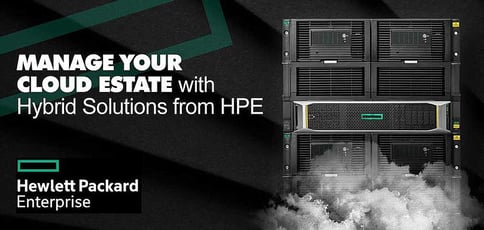
TL; DR: Hewlett Packard Enterprise (HPE) provides a portfolio of cloud products and services that enable businesses to build, deploy, and manage simplified hybrid environments. The company streamlines private, managed, and public clouds to improve speed and cost efficiency. Through software-defined infrastructure and consumption-based resources, HPE is reimagining the way its customers work.
One thing I learned from working as a cashier in my youth is that most people detest grocery shopping. I could see it in their body language as they stood in line with lifeless eyes and heavy heads. Today, I am that person. I would much rather pay for a prepared meal than run around the store on a maddening hunt for ingredients that I then have to go home and combine.
As it turns out, this feeling isn’t limited to the grocery store. Wayland Jeong, VP and GM of Hybrid Cloud Engineering, Software Defined, and Cloud Group at HPE, told us his company’s goal is to provide customers with a simplified hybrid environment rather than a hodgepodge of private, managed, and public clouds.
“The theme you’ll see with our company is we don’t offer point solutions — we’re not selling ingredients,” he said. “We’re selling the outcome, the meal.”

Wayland Jeong, VP and GM of Hybrid Cloud Engineering, Software Defined, and Cloud Group at HPE, told us the company relieves customers of the stress involved with juggling various cloud environments.
In a world where businesses often run on a mix of traditional and cloud resources, HPE’s goal is to simplify operations so they move at an optimal speed no matter where the data is.
Wayland has been with the company since its early days. “We started out as a hardware company, and we don’t shy away from the fact that we build great hardware,” he said. “Since then, we’ve refocused the company around delivering outcomes to our customers that are rooted in our hardware history.”
Today, HPE’s portfolio of cloud management products is making it simple for enterprises to build, deploy, and manage hybrid cloud environments. The company delivers a consistent experience across all clouds to improve speed while offering consumption-based resources that lower costs. With scalable solutions and a customer-centric internal development process, HPE is empowering users to shape their hybrid cloud environments around individual need.
Build, Deploy, and Manage a Simplified Hybrid Cloud Environment
When it comes to cloud computing, there’s nothing wrong with wanting the best of both worlds — after all, both public and private cloud solutions have unique benefits. Private clouds offer control, flexibility, and security, while public clouds are renowned for their affordability and low maintenance.
“Businesses want to take advantage of both the public cloud and the private cloud,” Wayland said. “But being able to incorporate enterprise controls and governance around all of that is really difficult. That’s why our mission is to make hybrid cloud simple for our customers.”
There are also cases where businesses must retain on-site infrastructure. Wayland told us data gravity often makes mobilization to the cloud impractical, and privacy is a concern in some cases (think GDPR). “Most of our enterprise customers live in a hybrid world by necessity,” he said. “There’s always going to be some amount of legacy infrastructure enterprises must manage.”

HPE helps reduce the complexity often faced when leveraging multiple cloud and on-premises infrastructure solutions.
While combining various cloud solutions with on-premises infrastructure often makes for a more flexible solution, the associated complexity can cause things to spiral out of control and ultimately slow innovation. “We provide solutions for operating, deploying, and managing the world of hybrid cloud,” Wayland said.
For example, HPE’s Pointnext is intended to reduce operational complications through digital advisory services. The group is dedicated to providing expertise in designing, implementing, and operating businesses via hybrid cloud solutions.
Bridge the Chasm Between DevOps and Governance with OneSphere
HPE OneSphere is a hybrid cloud management solution that simplifies and streamlines operations to boost performance and improve cost efficiency.
“A pattern that I see over and over again with medium and large-sized enterprises is they have a lot of business processes, yet they want to be agile with high velocity,” Wayland said. “It gives them a competitive advantage — as they say, ‘It’s no longer the big beating the small; it’s the fast beating the slow.’”
Wayland said these businesses see the value in moving their operations to the cloud but aren’t quite sure how to get there.

OneSphere: Helping companies merge traditional policies and cloud infrastructure to enhance outcomes.
“They need to bridge that division between a modern application development paradigm and their current business practices, including what’s required from a policy and security perspective,” he said. “If your company was born in the cloud, like Facebook or SalesForce, then this isn’t an issue. If you’re a Johnson & Johnson or Bank of America and you need to be more cloud-like, it is.”
Enter HPE OneSphere. The Software-as-a-Service solution allows users to manage their hybrid estate through a single pane of glass that is deeply integrated with the rest of the company’s portfolio — permitting them to watch over their enterprise with an eagle’s eye view. “We focused on building an entire solution that makes hybrid cloud simple for our customers, from the infrastructure up,” Wayland said.
Software-Defined, Composable Infrastructure Solutions
According to the International Data Corporation, the worldwide composable/disaggregated infrastructure market will be worth an estimated $751.5 million by the end of 2018 and reach $4.7 billion in 2023.
HPE is a pioneer in the technology, with over 1,600 customers leveraging its composable infrastructure solutions. Aimed at optimizing resources and improving agility, HPE’s composable infrastructure solution, known as HPE Synergy, is empowering organizations to meet the growing demand for flexible resources. The platform simplifies IT operations through a software-defined infrastructure for physical, virtual, and containerized workloads.
“Instead of buying sheet metal and motherboards and racking it up —knowing the way you configure it is how it will stay for eternity — what we’re driving with composable infrastructure is software-defined everything,” Wayland said. “You don’t need a forklift, screwdrivers, or tool belts to change it around.”
The solution combines AI with a unified API that leverages powerful tools from the HPE partner ecosystem. To that end, HPE acquired Plexxi earlier this year to extend its composable infrastructure portfolio.

HPE’s composable solutions simplify operations through software-defined infrastructure.
“Plexxi is focused on software-defined networking and application-driven network optimization,” Wayland said. “I’m excited about the acquisition and about how Plexxi will power a lot of our composability efforts.”
While the company is moving into infrastructure environments controlled by software, HPE is not turning its back on its hardware heritage. “We take our trusted hardware — our servers, blade systems, all of the great infrastructure we have — and make it so software can specify what that hardware looks like in terms of CPU, memory, storage, and how the network is configured,” Wayland said.
At the end of the day, HPE doesn’t want customers to think of its products as mere “boxes” placed on a server rack. “We’re really about the software that makes that ‘box’ meaningful in the context of the enterprise,” he said.
Providing Solutions That Change the Way Customers Work
Wayland credits HPE President and CEO Antonio Neri with the development and delivery of the company’s hybrid cloud solutions. Antonio joined HP in 1995 as a customer service rep, working his way up the ranks before being named President in 2017 and CEO a year later.
“HPE is a large company with a lot of history, and there’s a big advantage to understanding how the company works,” Wayland said. “Antonio’s been at the company for over 20 years and knows its roots on a deep level. He’s leading us forward — a true north star for the company.”
Wayland told us Antonio’s guiding vision for HPE is centered on improving each customer’s business journey so they can reach their final destinations with ease. “The focus is really around customer success and providing solutions that change the way people work,” Wayland said.
Though the company is hardly a startup, there are a number of startup-like businesses that fall under the HPE umbrella. This structure ensures that the business isn’t too big to work closely with its customers. For example, Wayland, who oversees HPE’s cloud products, takes a customer-focused approach to product development.
“We have design partnerships where we’ll get together with customers and provide them the ability to put feature requests into our backlog,” he said. “We also have regular design reviews with customers so they can essentially shape our products based on their needs.”
Forget grocery shopping — HPE customers get to create their own menu.
HostingAdvice.com is a free online resource that offers valuable content and comparison services to users. To keep this resource 100% free, we receive compensation from many of the offers listed on the site. Along with key review factors, this compensation may impact how and where products appear across the site (including, for example, the order in which they appear). HostingAdvice.com does not include the entire universe of available offers. Editorial opinions expressed on the site are strictly our own and are not provided, endorsed, or approved by advertisers.
Our site is committed to publishing independent, accurate content guided by strict editorial guidelines. Before articles and reviews are published on our site, they undergo a thorough review process performed by a team of independent editors and subject-matter experts to ensure the content’s accuracy, timeliness, and impartiality. Our editorial team is separate and independent of our site’s advertisers, and the opinions they express on our site are their own. To read more about our team members and their editorial backgrounds, please visit our site’s About page.

